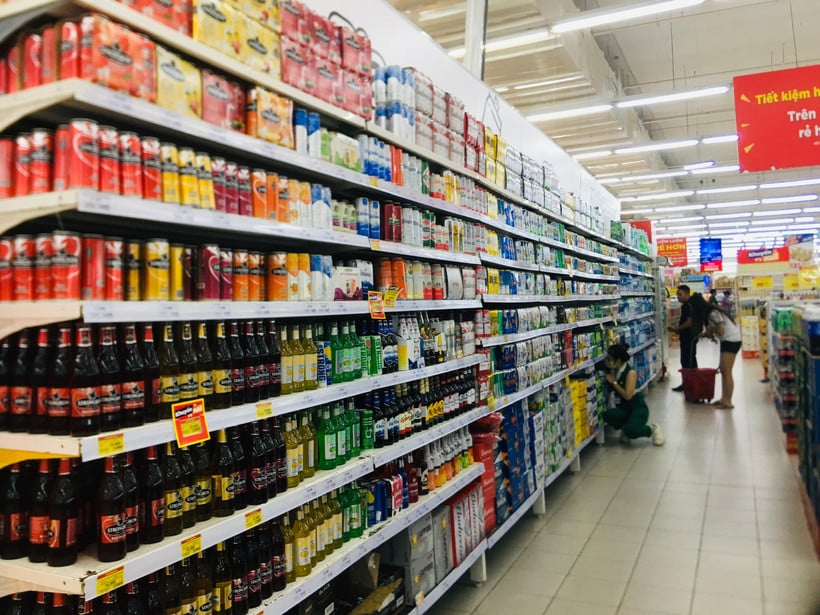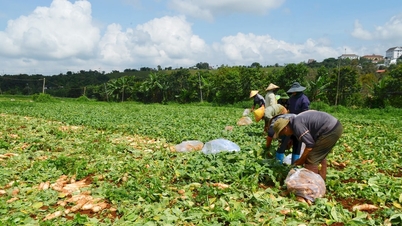 |
| In August, the food and catering services group decreased by 0.06%, partly due to the fluctuation in food prices, which decreased by 0.18%. (Photo: Vietnam+) |
On September 6, the General Statistics Office announced the consumer price index (CPI) for August, showing a macroeconomic "picture" with price pressures maintained at a certain level.
Accordingly, the average CPI for the first 8 months of the year increased by 3.25% compared to the same period in 2024, an increase that is within control but still requires close monitoring from management levels. Notably, rental housing prices and eating out continued to be the main factors pushing the CPI in August up by 0.05% compared to July.
More specifically, compared to December 2024, the CPI in August increased by 2.18% and compared to the same period last year, this index increased by 3.24%. Meanwhile, the core inflation index in 8 months recorded an increase of 3.19% over the same period, showing the relative stability of price factors that do not fluctuate according to seasonality or policy.
Eight commodity groups with price index increase
Analyzing this development further, Ms. Nguyen Thu Oanh, Head of the Service and Price Department, General Statistics Office, shared detailed information on the affected groups of goods and services. Specifically, in August, 8 groups of goods and services recorded price index increases, contributing to the overall increase of CPI.
Of which, the housing, electricity, water, fuel and construction materials group increased by 0.21% due to being greatly affected by many factors.
According to Ms. Oanh, house rental prices increased by 0.28% due to increased demand for rental housing in some localities in preparation for the new school year, when students and pupils returned to big cities to study. This put pressure on the housing market in big cities. Along with that, the electricity price index in August increased by 1.01%, reflecting a one-month lag compared to other items because it was calculated based on revenue and consumption output in July. The main reason was the prolonged hot weather causing a spike in electricity demand. In addition, the price of housing maintenance materials also increased by 0.49% due to high prices of bricks, sand, and stones when supply was scarce, production and transportation costs increased while construction demand remained high.
Along with that, the education group also recorded a significant increase of 0.21%. She said that the adjustment of tuition fees of some universities, private high schools and private kindergartens in some localities for the 2025-2026 school year was the main reason for the 0.21% increase in educational service prices. On the other hand, products serving learning also tended to increase in price, such as the price of paper products increased by 0.9%, pens of all kinds increased by 0.71% and stationery and other school supplies increased by 0.52%, due to the need to prepare for the new school year.
Not only that, the demand for shopping to prepare for the new school year also has a clear impact on the clothing, hats and footwear group. In fact, many families increase their demand for buying clothes and shoes for their children during this time. In particular, the price of fabrics of all kinds increased by 0.28%, clothing services increased by 0.27%, footwear increased by 0.18%, ready-made clothes and footwear services increased by 0.16% and hats increased by 0.07%.
Besides, the beverage and tobacco group increased by 0.17%, the household equipment and appliances group increased by 0.11%, and the other goods and services group increased by 0.11%.
Core price pressures remain under control
In contrast to the upward trend, three groups of goods and services recorded a decrease in price index in August, contributing to curbing the overall CPI increase. Specifically, the post and telecommunications group decreased by 0.04%. Ms. Oanh said that smartphones and tablets decreased by 0.63%, landlines decreased by 0.23% and regular mobile phones decreased by 0.12%. This shows that manufacturers and distributors are making efforts to reduce prices to attract customers.
Notably, the food and catering services group decreased by 0.06%, partly due to the fluctuation in food prices down 0.18%. Ms. Oanh explained in detail that pork prices decreased by 2.42% due to the complicated developments of African swine fever in some localities, making consumers worried about food safety and origin. This led to a decrease in animal fat prices by 1.72%, animal organs by 1.66%, frozen meat prices by 0.84% and processed meat prices by 0.42%. In addition, fresh and processed fruit prices also decreased by 1.51%.
The transport group decreased by 0.11%, mainly due to the adjustment of domestic gasoline prices. Specifically, the diesel price index decreased by 2.06%, the gasoline price index decreased by 0.2%. In addition, the price of used cars decreased by 0.58% and motorbikes decreased by 0.18%, due to businesses applying incentive programs to support consumers in shopping.
In addition to the overall CPI, the General Statistics Office said that core inflation (excluding food, fresh food, energy and state-managed goods including health and education services) increased by 0.19% month-on-month and 3.25% year-on-year. On average, core inflation increased by 3.19% year-on-year in the first eight months, lower than the 3.25% increase in the average CPI.
"This difference is mainly due to the prices of food, foodstuffs, electricity, medical services, and education services, which are factors that increase the overall CPI but are excluded from the core inflation calculation. This shows that if cyclical factors or policy factors are eliminated, core price pressure is still quite well controlled," Ms. Oanh explained.
The domestic gold market in August moved in line with the global trend, reflecting concerns about the global macro economy and monetary policy. As of August 30, the average world gold price was at 3,418.45 USD/ounce, up 1.47% compared to the previous month.
"The main reason is the expectation that the US Federal Reserve (FED) will cut interest rates, weakening the USD. In addition, geopolitical instability, buying activities of Central Banks and strong demand for gold in Asian markets have also impacted the world gold price," Ms. Oanh added.
Domestically, the gold price index in August increased by 1.2% compared to July, increased by 48.62% compared to the same period in 2024 and increased by 36.51% compared to December 2024. On average, in the first eight months of 2025, the gold price increased by an impressive 40.25% compared to the same period last year, showing that gold is still a "safe haven" in the context of inflation and instability.
In contrast to the gold price, the domestic USD price fluctuated in the opposite direction to the world price in August. As of August 30, the USD price index in the international market reached 98.11 points, down 0.14% compared to the previous month. However, the domestic USD price index increased by 0.36% compared to July and increased by 4.43% compared to the same period in 2024, thereby increasing by 3.67% compared to December 2024. On average, in the first eight months of 2025, the USD price increased by 3.45% compared to the same period last year, showing that exchange rate pressure still exists in the country, possibly due to interest rate differences, investment capital flows or import demand./.
Source: https://huengaynay.vn/kinh-te/cpi-tam-thang-tang-3-25-ap-luc-gia-ca-van-hien-huu-dang-ke-157507.html





![[Photo] Super harvest moon shines brightly on Mid-Autumn Festival night around the world](https://vphoto.vietnam.vn/thumb/1200x675/vietnam/resource/IMAGE/2025/10/07/1759816565798_1759814567021-jpg.webp)







































































































Comment (0)